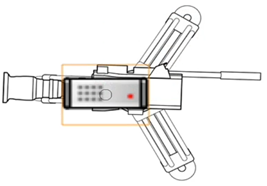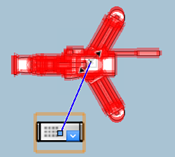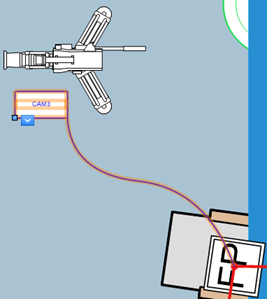 Placing equipment
Placing equipment
|
Tool |
Workspace: Tool set |
|
Equipment Item
|
Design Suite and Spotlight: ConnectCAD Layout ConnectCAD: Layout |
Equipment items can be placed stand-alone or within a rack, and they can be associated with other types of entertainment objects, which are considered as equipment items for cabling, etc. Equipment items are typically associated with devices on a schematic layer.
Rack equipment: If placed in a rack, equipment becomes associated with the rack, inheriting its ID/location and moving with the rack; if dragged out of a rack, equipment becomes disassociated. Modular equipment can optionally be placed within a rack frame located in the rack. To connect rack-mounted equipment to a cable path network, connect the rack. When equipment is placed in a rack, it rotates to match the rack's orientation and snaps to the nearest rack U or slot position. The floating Data bar displays the location; you can set the equipment's rack U position and slot number by entering values in the Data bar (see Using the Data bar).
To identify non-rack equipment with a room location, draw a polygonal layout room on the architectural floor plan with the Layout Room tool (see Creating a layout room).
Stand-alone equipment: Place equipment items in the model and connect them to the cable network; see Creating cable networks.
Drop points: Stand-alone equipment can function as a drop point (see Adding drop points). The Cable Route tool (see Creating cable networks) performs the same operations on selected equipment items and selected drop points. However, if an equipment item's handle is linked to one or more drop points (see Editing equipment), or if an equipment item is mounted in a rack and/or rack frame, the equipment item cannot function as a drop point.
Associated equipment items and objects: You can associate equipment items with Vectorworks Spotlight objects such as cameras, speakers, lighting devices, and video screens. Valid objects are available for placement from the Event Design tool set.
Associated third-party plug-in objects: You can associate equipment items with third-party plug-in objects. Vectorworks enables third-party developers to access and update equipment items attached to their plug-ins.
Associated devices and equipment items: If the name of the equipment matches that of an existing device, and Link device name is selected, the equipment automatically uses the device’s make and model number. Once the device and the equipment item are associated, the equipment parameters define the device's make and model, as well as its physical and location data.
If the drawing already contains devices, the Create Equipment command automatically creates an equipment item for each device; see Creating equipment items automatically.
To place equipment:
Do one of the following:
Click the tool.
Open the Resource Manager, open the folder containing the equipment items saved with the file or in the user folder, and then double-click an equipment item. The tool is activated. If you click Preferences mode, the dialog box displays the physical dimensions of the equipment item, and Use symbol is selected.
Click to place the equipment in the drawing, within an equipment rack or a rack frame, or over a valid object. The first time you use the tool in a file, a properties dialog box opens. Set the default parameters. The parameters can be edited later from the Object Info palette.
Click to show/hide the parameters.Click to show/hide the parameters.
|
Parameter |
Description |
|
X/Y/Z Rotation (stand-alone equipment required) |
Enter the rotation angle of the equipment along the X, Y, and/or Z axis |
|
General |
|
|
Name |
Enter the equipment name for labels and reports; if the name is the same as an existing device on a schematic layer, the device’s make and model information is automatically linked and entered. If attaching the equipment item to an object, name it after the corresponding device. Connect CAD can then recognize the corresponding device on the schematic. If needed, select Text > Size to change the size of the Name text only. Select Auto-size text to automatically resize the text to fit on one line. |
|
Link device name |
Associates the equipment item name with all devices that have the same name. Changing the equipment item name also changes the name of the associated devices. When this option is deselected, changing the equipment's name has no effect on the devices, and they become disassociated. |
|
Manufacturer |
|
|
Make/Model |
Enter the manufacturer’s make and model information |
|
Physical |
|
|
Height/Width/Depth |
Enter the dimensions of the equipment |
|
Power (W) |
Enter the power requirements of the equipment in watts |
|
Auto BTU calculation |
Automatically converts the power requirements of the equipment from watts to BTU units (BTU = power in watts x 3.41) |
|
BTU |
To enter power requirements manually, deselect Auto BTU calculation and enter the power requirements of the equipment in BTU units |
|
Weight (kg) |
Enter the equipment’s weight in kilograms |
|
Height RU |
Select the height of the equipment in rack units. If Allow half rack unit mountings is selected on the General Settings pane of the ConnectCAD Settings dialog box, you can also select half-rack units (see Specifying ConnectCAD settings). |
|
Rack Width |
Select whether the width of the item is constrained by the half or the full width of the equipment rack. Select non-rack to use any width, unconstrained by the rack or not placed within a rack. |
|
Mounting |
Select whether the equipment mounts to the front or rear of the equipment rack |
|
Mounting Depth |
Offsets the equipment from the rack by the specified distance |
|
Configuration |
|
|
Modular |
Indicates the equipment is modular, taking up several slots in the equipment rack |
|
Number of Slots |
Enter the number of slots occupied by a modular configuration |
|
Display |
|
|
Show text |
Toggles text display on the equipment item |
|
Auto-size text |
Resizes the Name text to fit on one line |
|
Text Align |
Select the text alignment for the Name label |
|
Use symbol |
Select the option, and then click to select an equipment item resource from the Resource Selector |
|
Location |
Specifies the containing layout room and equipment rack ID or drop point ID, as well as the rack location (in rack units and optionally half-rack units) and slot if placed in a rack frame. If only the rack ID is specified, the equipment is placed below the rack. If the equipment item is associated with a device on a schematic layer, the location information updates automatically for the device. If the equipment item functions as a drop point, Room is the only parameter that can be specified. |
|
Edit Schematic Device(s) |
Select to edit an associated device on a schematic layer. The option navigates to associated devices, which are automatically selected for editing. See Editing devices associated with equipment and rack frames. This option is enabled only when the equipment item has at least one associated device. |
Editing equipment
Equipment can be added to the drawing as a stand-alone object, or it can be added to equipment racks in a variety of ways. For more information, see Concept: Placing equipment into racks.
An equipment item object includes a handle, which is visible in 3D views. If you are creating a cable network, drag the handle to a cable path to connect it to the cable path network. Alternatively, you can connect the equipment to a drop point and then connect the drop point to the cable path; drag the handle to a drop point object to connect it; valid drop points are highlighted. Drag the handle off of the cable path or drop point to disconnect it (or select Detach from [object] or Detach from Drop Points from the object drop-down context menu).
You can connect multiple equipment items to a drop point by selecting all of the equipment handles with the Unrestricted Interactive Scaling mode of the Selection tool enabled. Drag the handles towards the drop point.
If the equipment item is a drop point, you cannot drag its handle to link to other drop points.
An equipment item can also be associated with a drawing object from the Event Design tool set. When placing the equipment item, place it on the valid object. Valid objects are highlighted at placement; after placement, the equipment item is identified as an icon (in Top/Plan view) or a locus (in 3D views) over the object.

Alternatively, after placement, drag the equipment item's handle to the object to attach it. Once the equipment item and the object are associated, they move together. Next, attach the equipment item to a cable path network or to a drop point. You can also use the Cable tool from the Cable Route tool set to make this connection.


Attaching an equipment item to a camera, and attaching the equipment item to a drop point
Detach the equipment item from the object or drop point using the drop-down context menu. Select the Detach From [object] or Detach from Drop Points command.
Creating equipment detail views
|
Command |
Workspace: Path |
|
Create Equipment Detail View |
Design Suite: Entertainment > ConnectCAD Layout Spotlight: Spotlight > ConnectCAD Layout ConnectCAD: ConnectCAD > Layout |
The Create Equipment Detail View command creates a sheet layer with section viewports that display the front and/or rear views of equipment items. If the equipment items have adapter slots (see Placing adapter slots), the adapter slots display in the viewports.
To create an equipment detail view section viewport:
Select one or more equipment items, and then select the command.
The Create Equipment Detail View dialog box opens.
Click to show/hide the parameters.Click to show/hide the parameters.
|
Parameter |
Description |
|
Sheet Layer (Destination) |
Select the sheet layer for the equipment detail view |
|
Viewport Name |
Specify a name for the viewport |
|
Views to Create |
Select whether to create a viewport for the front, rear, or both views. The default viewport name is "Equipment Detail" [name] with either an F or R appended to indicate the view. |
Select the sheet layer for the viewport, or select New Sheet Layer to create a sheet layer; specify a viewport name, and select which views to create.
An equipment detail view section viewport is created for each view.

